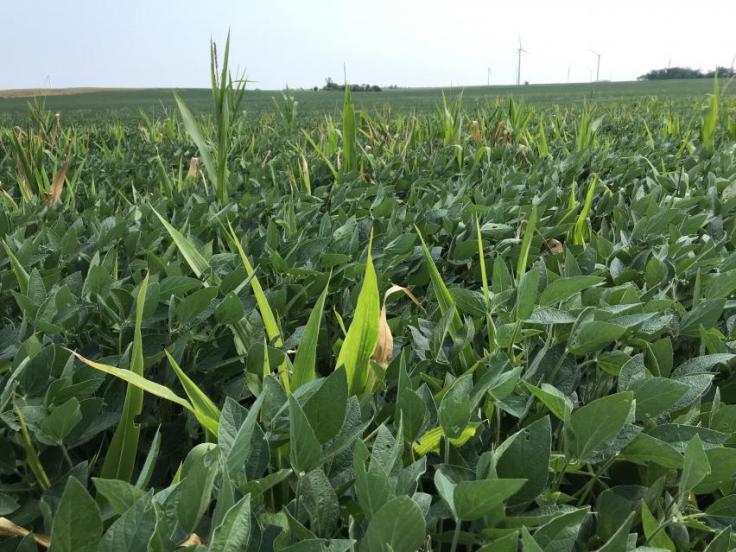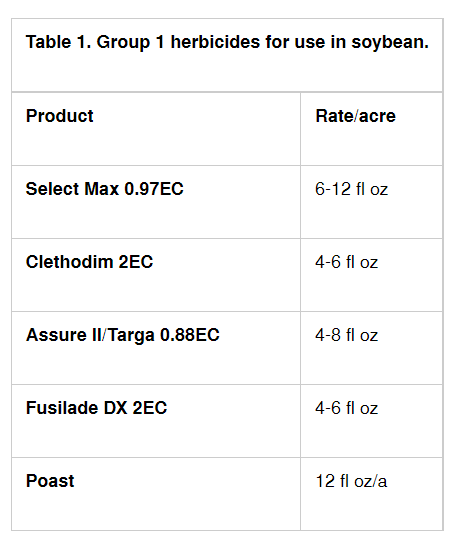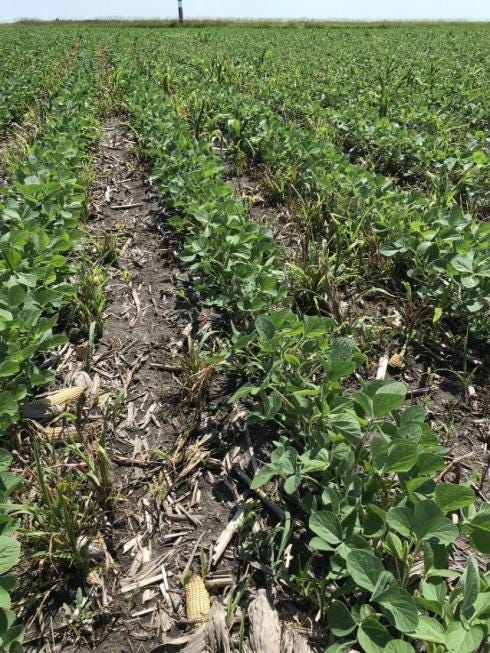September 15, 2021

The derecho left many Iowa farmers with significant volunteer corn this growing season, and unfortunately some may be facing a similar situation for 2022 after late August storms flattened fields.
While corn killed during early reproductive stages, the kernels may not survive the winter well, corn killed during or after the R5 growth stage, the kernels are more likely to survive the winter and be viable to germinate next growing season. Losses of only a few bushels per acre can result in significant volunteer corn populations. Volunteer corn ranging from 800 to 13,000 plants per acre can cause yield losses up to 54% in soybean and up to 13% in corn, according to research conducted at SDSU, UMN, and UNL. Besides yield losses, volunteer corn can allow corn rootworm and corn pathogens to persist and cause issues to corn in future years. It is important to develop plans to control volunteer corn starting this fall.
Know what you grew: One of the biggest challenges for 2021 was determining whether planting corn was a reasonable decision in fields with significant harvest losses or unharvested corn. The best option for many storm-damaged fields is to rotate to soybean next year. Going back to corn next year is feasible only in fields where a herbicide option, like glyphosate or glufosinate, exists to kill volunteer plants.
Fall management: Much debate exists over the effectiveness of tillage in managing volunteer corn. While fall tillage operations to size residue may increase seed-soil contact and promote germination of corn seeds this fall, any seed left on the surface is less likely to germinate due to lack of soil-seed contact and vulnerability to seed predation. For some farmers, grazing fields or baling some crop residue is an option that will help reduce volunteer corn in fields with significant lodging.
Preplant options in the spring: Tillage or non-selective herbicides, such as Gramoxone SL (paraquat), can be used to kill volunteer corn that emerges before crop planting. Products containing clethodim can be used prior to planting corn, but there is a strict rate limitation and 6 day replant interval due to the potential for corn injury. If conventional corn was grown this year, glyphosate would be an additional effective burndown herbicide. While preplant tillage can kill emerged plants, it will likely break up ears and stimulate corn germinatation and emergence. The majority of volunteer corn will emerge after crop planting in the spring.
Management in 2022 soybean: Table 1 lists Group 1 grass herbicides (ACC-ase inhibitors) that can be used to control corn volunteers in soybean.

To reduce early-season crop competition, it is recommended to apply these products when emerged volunteer corn is 12 inches or less. Consult the product label for appropriate adjuvants (NIS, COC, MSO) to enhance the activity of these products for controlling volunteer corn in soybean.
Fields that will be planted to a soybean variety with glufosinate tolerance can be treated with Liberty to control volunteer corn if the corn grown in 2021 was conventional or Roundup Ready only. Two applications of glufosinate (32-43 fl oz/acre) are recommended in LibertyLink soybean. Group 1 grass herbicides (Table 1) will be the only option for controlling volunteer corn in soybean if the 2021 corn hybrid was tolerant to both glyphosate and glufosinate.
HG1 antagonism with broadleaf herbicides in soybean: The biggest lesson learned from 2021 is the dramatic reduction in efficacy that tank mix partners like 2,4-D (Enlist soybean) and dicamba (Xtend/Xtendflex) soybean can have on HG1 products (Figure 2). Antagonism generally can be reduced by applying a higher rate of the grass herbicide in the tank-mix or avoided by applying the grass herbicide one or more days before or 7 days after the broadleaf herbicide. As a result of antagonism issues, many derecho-affected fields required an additional POST pass containing only a Group 1 product in 2021.

Management in 2022 corn: If a Roundup Ready only hybrid was planted this season, switching to LibertyLink or stacked LibertyLink + Roundup Ready hybrid would be an option for 2022. Liberty can be used to control Roundup Ready volunteer corn. Two applications of Liberty, each of 32-43 fl oz/acre, can be made in LibertyLink corn.
If the previous year’s corn was Roundup Ready + LibertyLink hybrid, Enlist corn may be an option for some farmers. Enlist corn includes stacked resistance to 2,4-D choline, glyphosate, and ‘fop’ grass herbicides. Assure II (quizalofop-p-ethyl) is the only grass herbicide labeled to control volunteer corn in Enlist Corn. It can be applied at 5 to 12 fl oz/acre in Enlist Corn for selective control of Roundup Ready + LibertyLink volunteer corn. Follow label recommendations for timing and appropriate adjuvants.
In the unfortunate case where lodged corn creates a significant potential for 2022 volunteer corn, putting a plan in place now while 2021 corn hybrid information is still fresh on the mind will help reduce the inconvenience of this issue in 2022.
Source: Iowa State University, which is solely responsible for the information provided and is wholly owned by the source. Informa Business Media and all its subsidiaries are not responsible for any of the content contained in this information asset.
You May Also Like




